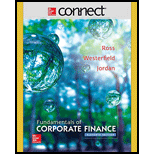
Concept explainers
a.
To determine: Choosing between the two stocks.
Introduction: Expected Return is a process of estimating the
a.
Answer to Problem 37QP
Solution: Stock B should be chosen.
Explanation of Solution
Determine the Stock Return for each state of economy
Generally a risk-averse investor expects greater return and less risks. A risk-averse investor who holds a portfolio that is well-diversified, beta is the fitting measure of the risk of an individual security. To choose between the two stocks we need to calculate the beta and expected return of the two stocks. As Stock A does not pay any dividend and the return on Stock A is,
Therefore the Stock Return for Recession is -14.70%, Normal is 16% and Expansion is 29.30%
Determine the Expected Return for Stock A
Therefore the Expected Return for Stock A is 12.53%
Determine the Variance for Stock A
Therefore the Variance for Stock A is 0.021163
Determine the Standard Deviation for Stock A
Therefore the Standard Deviation for Stock A is 14.55%
Determine the Beta for Stock A
Therefore the Beta for Stock A is 0.57
Determine the Beta for Stock B
Therefore the Beta for Stock A is 0.45
Result:
Stock A has an expected return lower than Stock B. A stock’s beta is determined using the beta of the stock. Stock A’s beta is higher than Stock B. A risk-averse investor who holds a well-diversified portfolio should chose Stock B because in this condition it explains that at least one of the stocks is not priced correctly due to greater beta or greater risk. The stock has a low return than the low risk of the stock.
b.
To determine: The Expected Return and Standard Deviation of Portfolio.
b.
Answer to Problem 37QP
Solution: The Expected Return is 12.97% and Standard Deviation of Portfolio is 16.81%.
Explanation of Solution
Determine the Expected Return on Portfolio
Therefore the Expected Return on Portfolio is 12.97%
Determine the Variance on Portfolio
Therefore the Variance on Portfolio is 0.028257
Determine the Standard Deviation on Portfolio
Therefore the Standard Deviation is 16.81%.
c.
To determine: The Beta of Portfolio.
c.
Answer to Problem 37QP
Solution: The Beta of Portfolio is 0.532.
Explanation of Solution
Determine the Beta of Portfolio
Therefore the Beta of Portfolio is 0.532
Want to see more full solutions like this?
Chapter 11 Solutions
CONNECT 1 SEMESTER ACCESS CARD FOR CORPORATE FINANCE
- The standard deviation of stock returns for Stock A is 40%. The standard deviation of the market return is 20%. If the correlation between Stock A and the market is 0.70, then what is Stock A’s beta?arrow_forwardA stock is trading at $80 per share. The stock is expected to have a yearend dividend of $4 per share (D1 = $4), and it is expected to grow at some constant rate, g, throughout time. The stock’s required rate of return is 14% (assume the market is in equilibrium with the required return equal to the expected return). What is your forecast of gL?arrow_forwardCrisp Cookware’s common stock is expected to pay a dividend of $3 a share at the end of this year (D1 = $3.00); its beta is 0.8. The risk-free rate is 5.2%, and the market risk premium is 6%. The dividend is expected to grow at some constant rate g, and the stock currently sells for $40 a share. Assuming the market is in equilibrium, what does the market believe will be the stock’s price at the end of 3 years (i.e., what is )?arrow_forward
 EBK CONTEMPORARY FINANCIAL MANAGEMENTFinanceISBN:9781337514835Author:MOYERPublisher:CENGAGE LEARNING - CONSIGNMENT
EBK CONTEMPORARY FINANCIAL MANAGEMENTFinanceISBN:9781337514835Author:MOYERPublisher:CENGAGE LEARNING - CONSIGNMENT
 Intermediate Financial Management (MindTap Course...FinanceISBN:9781337395083Author:Eugene F. Brigham, Phillip R. DavesPublisher:Cengage Learning
Intermediate Financial Management (MindTap Course...FinanceISBN:9781337395083Author:Eugene F. Brigham, Phillip R. DavesPublisher:Cengage Learning



